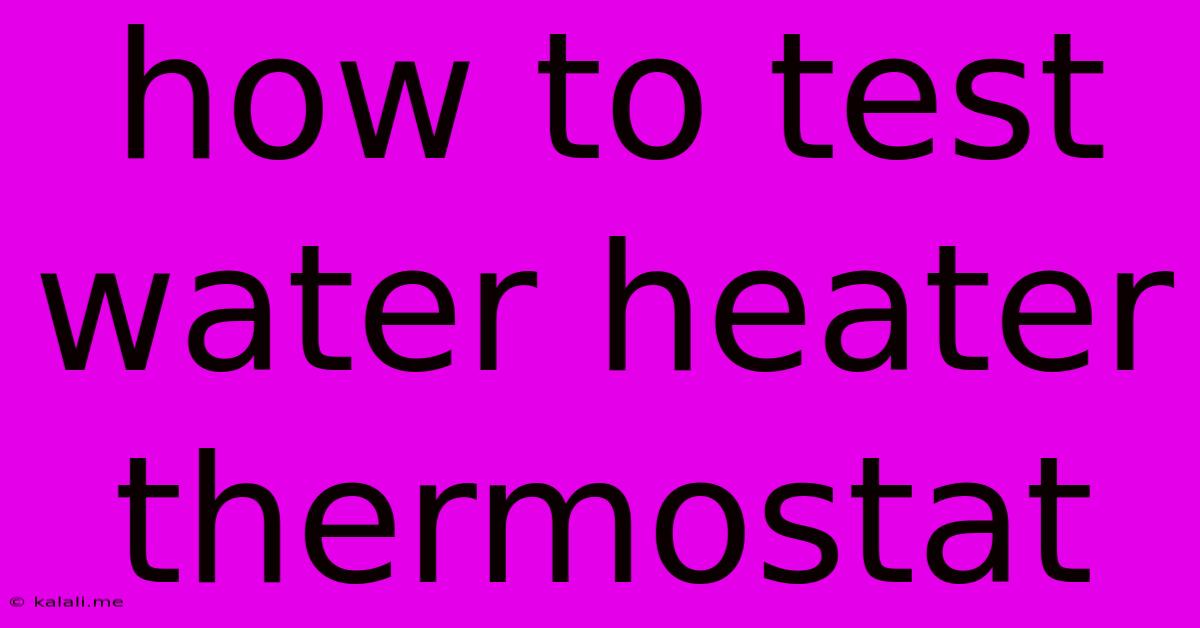How To Test Water Heater Thermostat
Kalali
May 25, 2025 · 4 min read

Table of Contents
How to Test a Water Heater Thermostat: A Step-by-Step Guide
Meta Description: Learn how to troubleshoot a malfunctioning water heater by testing its thermostat. This step-by-step guide provides clear instructions and safety precautions for accurate testing. Avoid costly repairs by identifying the problem yourself!
Is your water heater failing to reach the desired temperature, or perhaps producing scalding hot water? The culprit might be a faulty thermostat. Before calling a plumber and incurring potentially expensive repair bills, you can perform a simple test yourself. This guide will walk you through how to test your water heater thermostat safely and effectively.
Understanding Your Water Heater Thermostat
The thermostat in your water heater is a crucial component that regulates the water temperature. It acts as a temperature sensor and switch, turning the heating element on and off to maintain your set temperature. A malfunctioning thermostat can lead to inconsistent water temperatures, or even complete heating failure. There are two main types:
- Lower Thermostat: Controls the lower heating element (if your water heater has two elements).
- Upper Thermostat: Controls the upper heating element (if your water heater has two elements). Some models only have a single thermostat.
Testing the thermostat involves checking its continuity – the ability of electricity to flow through it. Always disconnect the power to your water heater before starting any testing. This is crucial for your safety and to prevent electric shock.
Tools You'll Need
Before you begin, gather the following:
- Screwdriver (Phillips and flathead): For accessing the thermostat and its wiring.
- Multimeter: This essential tool measures electrical continuity and voltage. Make sure it's set to the ohms (Ω) setting.
- Wire strippers/cutters (optional): If you need to make any wire adjustments.
- Pen and paper: To record your readings.
- Safety glasses: To protect your eyes.
Step-by-Step Guide to Testing Your Water Heater Thermostat
1. Safety First! Turn Off the Power: Locate the circuit breaker controlling your water heater and turn it OFF. Double-check that the power is off by using a non-contact voltage tester on the water heater's terminals.
2. Access the Thermostat: The location of the thermostat varies depending on your water heater model. It's usually located on the top or side of the tank, behind an access panel. Consult your water heater's manual if you're unsure where to find it. Remove the access panel carefully.
3. Identify the Thermostat Wiring: The thermostat will have two or more wires connected to it. Carefully note the location and color of each wire before disconnecting them. Take photos if it helps.
4. Disconnect the Wires: Carefully disconnect the wires from the thermostat terminals. Use a label or marker to keep track of which wire goes to which terminal.
5. Test for Continuity: Set your multimeter to the ohms (Ω) setting. Touch the multimeter probes to each thermostat terminal. A good thermostat will show a low resistance reading (usually close to zero ohms). A reading of infinity (OL) indicates an open circuit, suggesting a faulty thermostat.
6. Repeat for Each Terminal Pair (if applicable): If your water heater has two thermostats, repeat steps 4 and 5 for each one.
7. Test the Heating Element (optional but recommended): While you have access to the wiring, consider testing the heating element as well. This involves checking for continuity between the element terminals. A faulty element could also be the reason for your water heating issues. Again, consult your water heater manual for specific instructions.
8. Reconnect and Test: If the thermostat tests good, carefully reconnect the wires to the thermostat terminals, ensuring they are securely connected. Turn the breaker back on and monitor your water heater for proper operation. If the problem persists, you might have a more complex issue requiring professional assistance.
Interpreting Your Results
- Low resistance (near zero ohms): The thermostat is likely functioning correctly.
- Infinity (OL): The thermostat is likely faulty and needs replacement.
When to Call a Professional
If you are uncomfortable working with electricity, or if you are unable to identify the problem after testing the thermostat and heating element, it's best to call a qualified plumber or appliance repair technician. Attempting complex repairs without proper knowledge can be dangerous and may void any warranties.
By following these steps, you can effectively test your water heater thermostat and potentially save yourself time and money. Remember safety is paramount – always disconnect the power before working on any electrical appliance.
Latest Posts
Latest Posts
-
What Do You Call Someone Who
May 25, 2025
-
Wiring Two Lights And A Switch
May 25, 2025
-
How To Get Suction Cups To Stick To Tile
May 25, 2025
-
Includes But Not Limited To Punctuation
May 25, 2025
-
You Get More With Honey Than Vinegar
May 25, 2025
Related Post
Thank you for visiting our website which covers about How To Test Water Heater Thermostat . We hope the information provided has been useful to you. Feel free to contact us if you have any questions or need further assistance. See you next time and don't miss to bookmark.